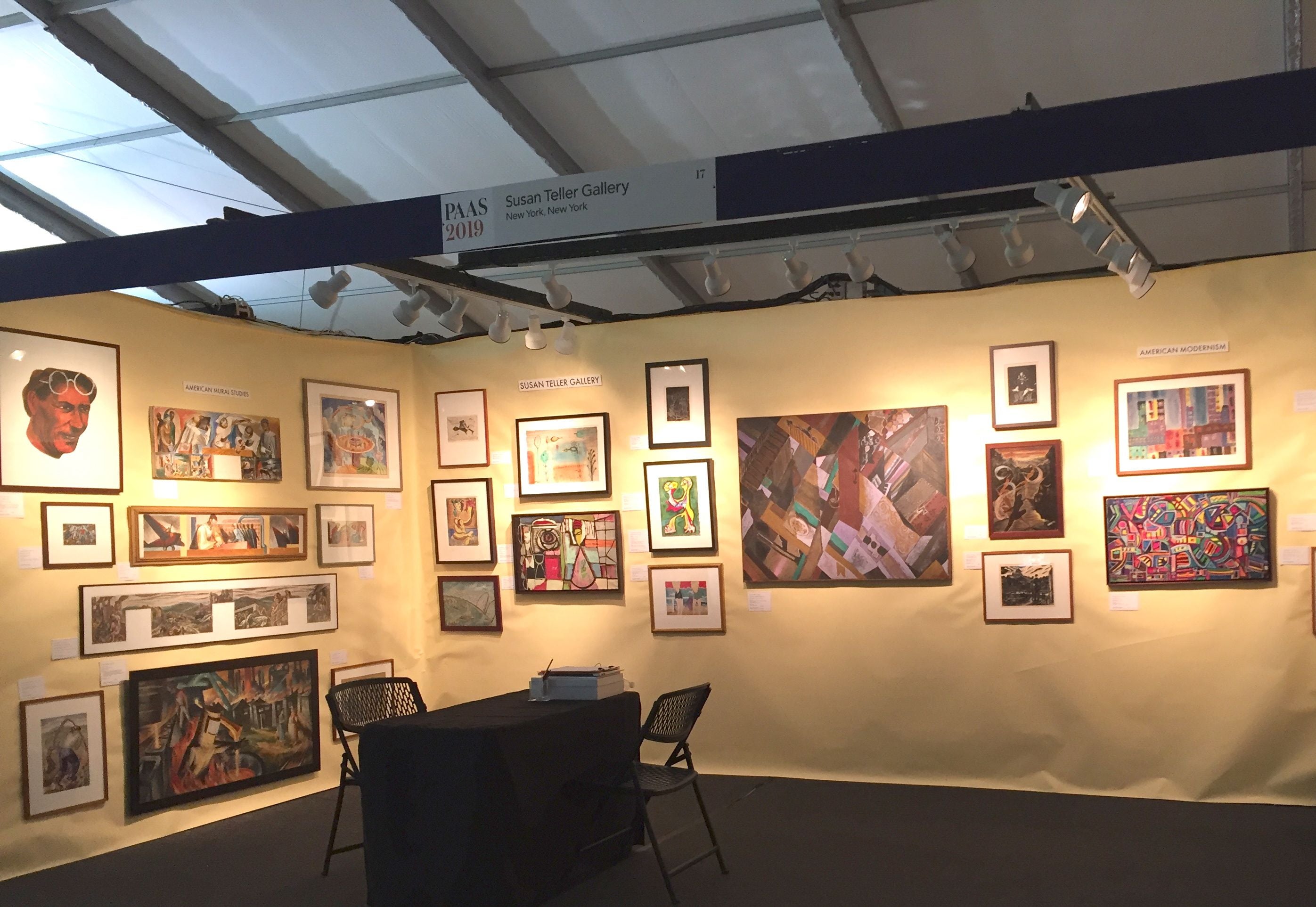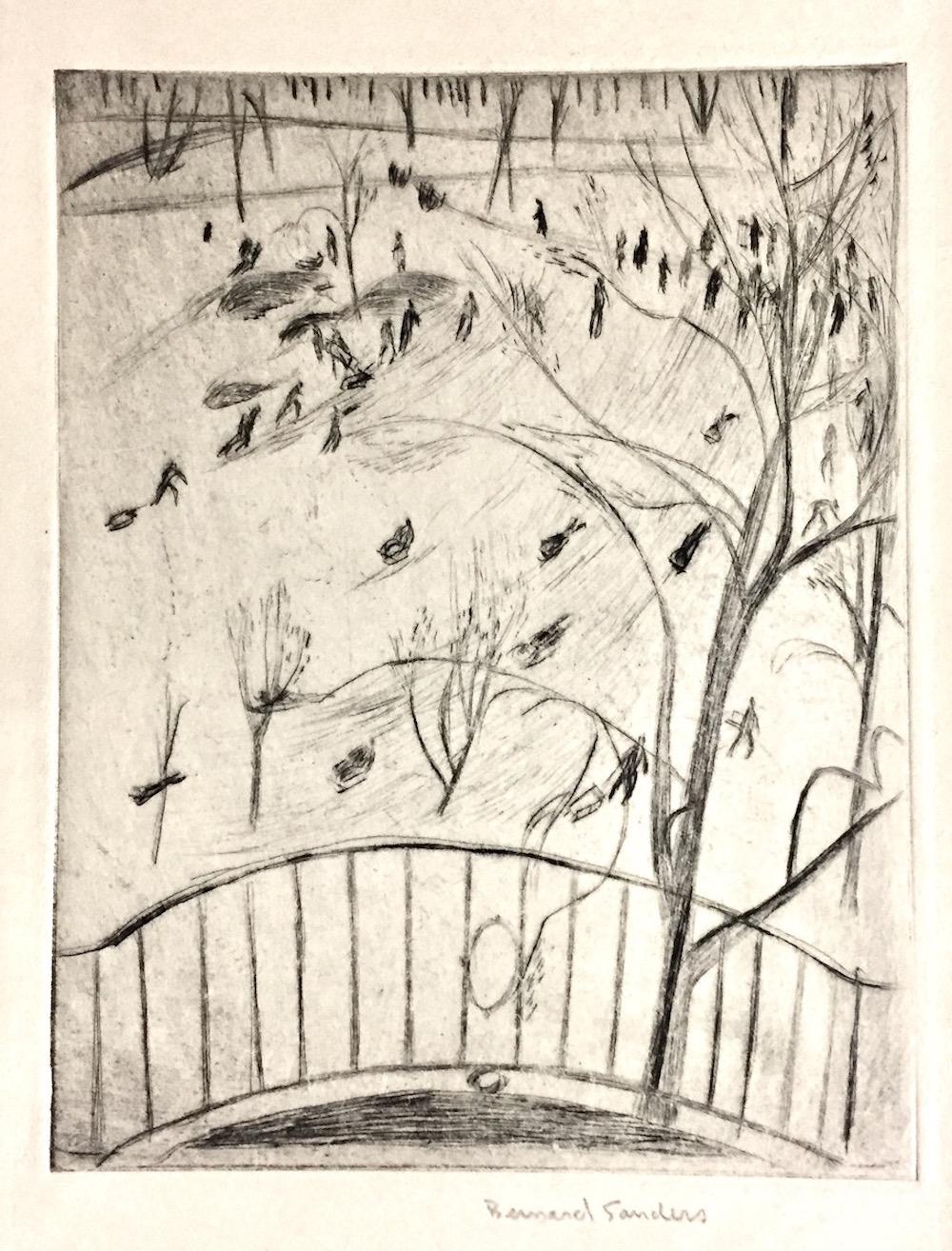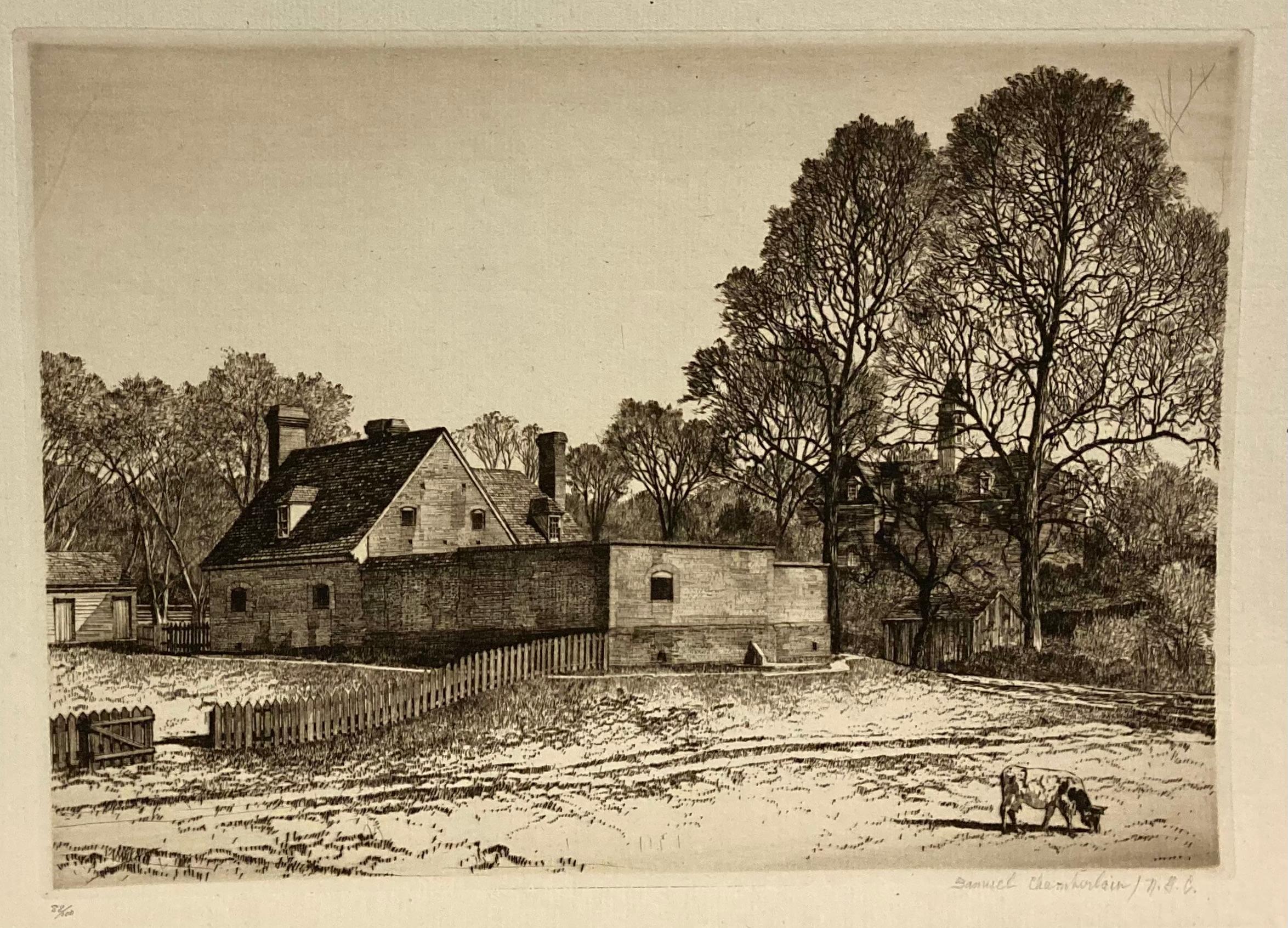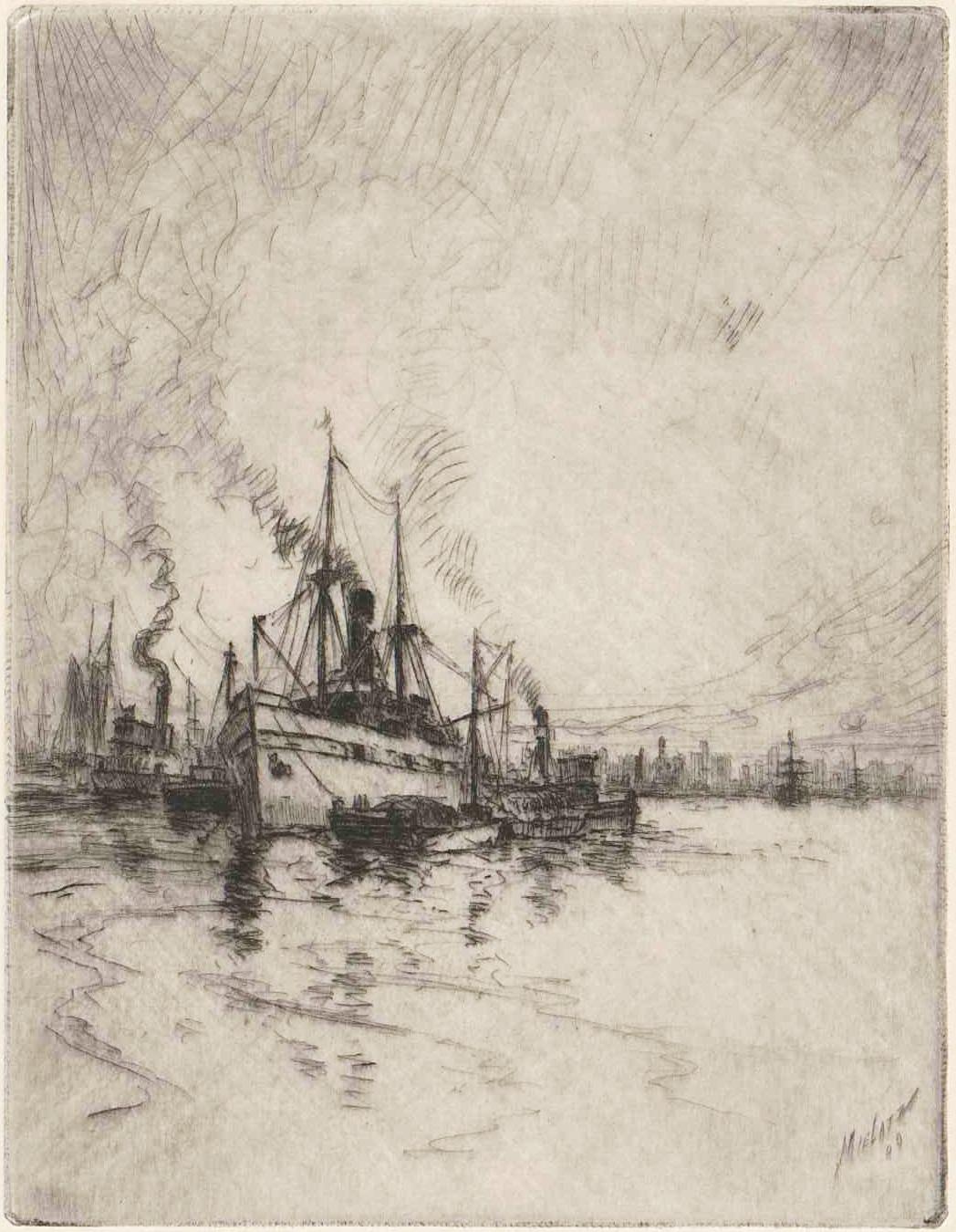Items Similar to Armin Landeck, Tenement Walls
Want more images or videos?
Request additional images or videos from the seller
1 of 5
Armin LandeckArmin Landeck, Tenement Walls1942
1942
About the Item
The reference number on this work is Kraeft 88. It's from an edition of 100 and is signed, dated, and numbered, in pencil.
Always an intaglio printmaker, Landeck switched from a more atmospheric drypoint technique to engraving while working at Stanley William Hayter's New York Atelier 17, in the 1940s. As this is a drypoint it dates from Landeck's career prior to his association with Hayter.
This is view of 'Tenement Walls' includes a slice of a city backyard complete with clothesline and hanging wash. The repeated windows, with individual curtains, enforce the 'cookie cutter' feeling of tenement apartments.
- Creator:Armin Landeck (1905-1984, American)
- Creation Year:1942
- Dimensions:Height: 10.63 in (27.01 cm)Width: 8 in (20.32 cm)
- Medium:
- Movement & Style:
- Period:
- Condition:This work is in extremely good condition.
- Gallery Location:New York, NY
- Reference Number:1stDibs: LU141028470802

About the Seller
5.0
Gold Seller
These expertly vetted sellers are highly rated and consistently exceed customer expectations.
Established in 1988
1stDibs seller since 2020
86 sales on 1stDibs
Typical response time: 3 hours
- ShippingRetrieving quote...Ships From: New York, NY
- Return PolicyA return for this item may be initiated within 7 days of delivery.
More From This SellerView All
- Irving Guyer, Christmas Trees on Second Street (NYC)By Irving GuyerLocated in New York, NYPhiladelphia-born Irving Guyer attended the Art Students League and worked in New York City before moving to California. This print is signed and titled i...Category
1930s American Modern Figurative Prints
MaterialsDrypoint, Etching
- Bernard Sanders, Sledding in Central Park, NYCLocated in New York, NYSigned in pencil. This scene is a hundred years old but if we have snow this year it can easily be recreated.Category
Early 20th Century American Modern Landscape Prints
MaterialsDrypoint
- Samuel Chamberlain, The Public Gaol, Williamsburg (Virginia)By Samuel ChamberlainLocated in New York, NYSamuel Chamberlain was a superb draftsman and his architectural images are often very complex. This image is, by contrast, quiet and understated: serene to the point of lonely. It's ...Category
1930s American Modern Figurative Prints
MaterialsDrypoint
- Werner Drewes, 125th Street at Broadway, NYCBy Werner DrewesLocated in New York, NYWerner Drewes brought his modernist vision to this subject but created, in my opinion, a great work of the Etching Revival. The reference is Rose 183. It...Category
1930s American Modern Landscape Prints
MaterialsDrypoint
- Alfred Bendiner, Place St. Andre des Arts (Paris)By Alfred BendinerLocated in New York, NYThe Place St. Andre des Arts, on the Left Bank in Paris, would have been a natural environment for Bendiner. It was the Latin Quarter, just south of the Louvre and near everything im...Category
1950s American Modern Landscape Prints
MaterialsLithograph
- Walter DuBois Richards, The Lobster FloatBy Walter DuBois RichardsLocated in New York, NYOhio-born Walter DuBois Richards (1907-2006) was educated at the Cleveland School of Art. He re-located to New York around 1933 where he had a successful career as a commercial artis...Category
1930s American Modern Landscape Prints
MaterialsWoodcut
You May Also Like
- Guardians of the Spire; Amiens Cathedral Number 2By John Taylor ArmsLocated in Middletown, NYGuardians of the Spire; Amiens Cathedral Number 2 New York: 1937. Etching and drypoint on watermarked F.J. Head cream-colored, antique laid paper, 6 3/4 ...Category
Mid-20th Century American Modern Figurative Prints
MaterialsDrypoint, Etching
- Tugs on the HudsonBy Charles Frederick William MielatzLocated in Middletown, NYDrypoint etching with engraving printed in black ink on Japanese mulberry paper, 4 1/2 x 3 3/8 inches (113 x 84 mm), full margins. In superb condition. A beautiful New York City rive...Category
Early 20th Century American Modern Landscape Prints
MaterialsHandmade Paper, Drypoint, Etching
- Palazzo dell'AngeloBy John Taylor ArmsLocated in Middletown, NYPalazzo dell'Angelo 1931 Etching and drypoint on cream-colored, handmade laid paper with deckle edges, 7 1/4 x 6 3/4 inches (185 x 171 mm), edition of 100, full margins. Signed, dated and numbered "Ed. 100" in pencil, lower margin, second state (of three). Printed by Henry Carling, New York. Extremely minor mat tone and some inky residue in the top right corner, all unobtrusive and well outside of image area. An exquisite impression of this intricate image, with astonishing detail, and all the fine lines printing clearly. The image represents the first print which Arms printed on his own handmade paper. Framed handsomely with archival materials and museum grade glass in a wood gilt frame with a flower and garland motif. Illustrated: Dorothy Noyes Arms, Hill Towns and Cities of Northern Italy, p. 180; Anderson, American Etchers Abroad 1880-1930; Eric Denker, Reflections & Undercurrents: Ernest Roth and Printmaking in Venice, 1900-1940, p. 116. [Fletcher 233] Born in 1887 in Washington DC, John Taylor Arms studied at Princeton University, and ultimately earned a degree in architecture at the Massachusetts Institute of Technology in 1912. With the outbreak of W.W.I, Arms served as an officer in the United States Navy, and it was during this time that he turned his focus to printmaking, having published his first etching in 1919. His first subjects were the Brooklyn Bridge, near the Navy Yard, and it was during his wartime travel that Arms created a series of extraordinarily detailed etchings based on Gothic cathedrals and churches he visited in France and Italy. He used what was available to him, namely sewing needles and a magnifying glass, to create the incredibly rich and fine detail that his etchings are known for. Upon his return to New York after the war, Arms enjoyed a successful career as a graphic artist, created a series of etchings of American cities, and published Handbook of Print Making and Print Makers (Macmillan, 1934). He served as President of the Society of American Graphic Artists, and in 1933, was made a full member of the National Academy of Design. In its most modern incarnation, Palazzo dell'Angelo was constructed in or around 1570. The building, which has a rich and storied history, was erected upon the ruins of an earlier structure which predates the Gothic period. Some remnants of the earliest features of the residence were most certainly still visible when Arms visited, as they are today. Having a background in architecture, there's no question that Arms was moved by the beauty, history and ingenuity represented in the physical structure. One thing specifically gives away Arms's passion for the architecture, and that is the fact that he focused on the building's Moorish entranceway, balustrade, and two mullioned windows, and not on the curious Gothic era bas-relief of an angel nestled into the facade of the building, after which the structure is named. The sculpture itself doesn't appear in Arms's composition at all, despite the fact that it is the feature of the building that is most famous in its folklore. Arms instead focuses on the oldest portion of the architecture, even documenting some of the remnants of a fresco, and a funerary stele for the freedman Tito Mestrio Logismo, and his wife Mestria Sperata (visible above the water level, to the left of the door, behind the gondola), which was first described in 1436. Among the many notable bits of history regarding the Palazzo, it has been documented that Tintoretto painted frescos of battle scenes on the facade of the building. The paintings have been lost to time and the elements, but not entirely to history. The empty frame...Category
1930s American Modern Figurative Prints
MaterialsDrypoint, Etching
- Steps to the Grand Canal, St. Mark's in the distance, Venice.By Donald Shaw MacLaughlanLocated in Middletown, NYA lovely view of Venice from the water. Etching with drypoint on antique cream laid paper with a large figural watermark, signed in pencil, lower right. 14 1/4 x 11 inches (362 x 280...Category
Early 20th Century American Modern Landscape Prints
MaterialsLaid Paper, Drypoint, Etching
- The Old Smyth Gate, Charleston, South CarolinaBy Alfred HuttyLocated in Middletown, NYA view of the gateway to Simmons-Edwards House (14 Legare Street), also known as the Pineapple Gate House. Etching with drypoint on watermarked "Hand Made" laid paper, signed in pen...Category
Early 20th Century American Modern Landscape Prints
MaterialsLaid Paper, Drypoint, Etching, Handmade Paper
- Low Country (South Carolina)By Elizabeth VernerLocated in Middletown, NYAn enchanting Southern landscape by the mother of the Charleston Renaissance. A native of Charleston, South Carolina, and educated under the tutelage of Thomas Anshutz at The Pennsylvania Academy of Fine Arts, O'Neill Verner was a teacher, a mother, an artist, an ardent preservationist, and a skilled autodidact. Having previously focused on painting, in the early 1920s she found herself deeply moved by printmaking as a media, and especially so by the simple, peaceful themes and tableaus she discovered in Japanese art. She embarked on a effort to teach herself Japanese printmaking techniques, and in the process, produced the charming images of every day life in Charleston and its environs that earned her recognition as a cultural icon in her day, and in more modern times, as the mother of the Charleston Renaissance, which flourished well into the 1930s. In 1923 she opened a studio in Charleston where she focused on documenting the local color and the architecture and landscape that distinguishes Charleston as one of the South's most beautiful cities, all the while applying the gentle and poetic thematic sensibilities of Japanese printmaking. O'Neill Verner soon found herself in high demand when municipalities and institutions throughout the country sought commissions from her to document the beauty of their grounds and historic buildings. She worked as far north as the campuses of Harvard and Princeton, and extensively across the South, including in Savannah, Georgia, where through sweeping commissions she was able to marry her love of southern preservation and art. O'Neill Verner was a lifelong learner, and continued a path of edification that led her to study etching at the Central School of Art in London, to travel extensively through Europe, and to visit Japan in 1937, where she studied sumi (brush and ink) painting. She was a founding member of the Charleston Etchers Club, and the Southern States Art League. Her works are represented in the permanent collections of leading museums across the American south, and in major national institutions including the Metropolitan Museum of Art, Boston's Museum of Fine Art, and the Smithsonian American Art Museum. O'Neil Verner...Category
Early 20th Century American Modern Landscape Prints
MaterialsArchival Paper, Drypoint, Etching
Recently Viewed
View AllMore Ways To Browse
Printed Wall Hanging
Vintage Window Wall Art
Vintage Cutters
Vintage Cutter
Printed Curtains
New Curtains
Vintage Cookies
Retro Mid Century Curtains
Vintage Window Curtains
Clothesline Vintage
Chicago Travel Poster
African Woman Nude
Antique Charcoal Painting
Nude Boy Painting
Drawing Roman Head
Deco Pochoir Prints
Madrid Vintage Clothing
Piano Dress




